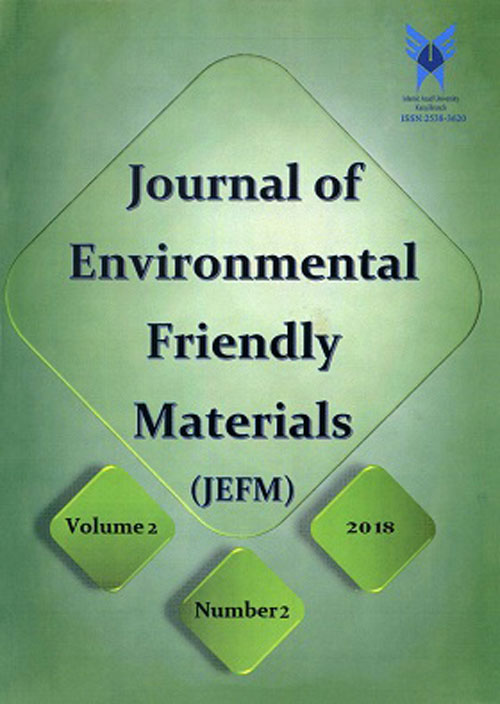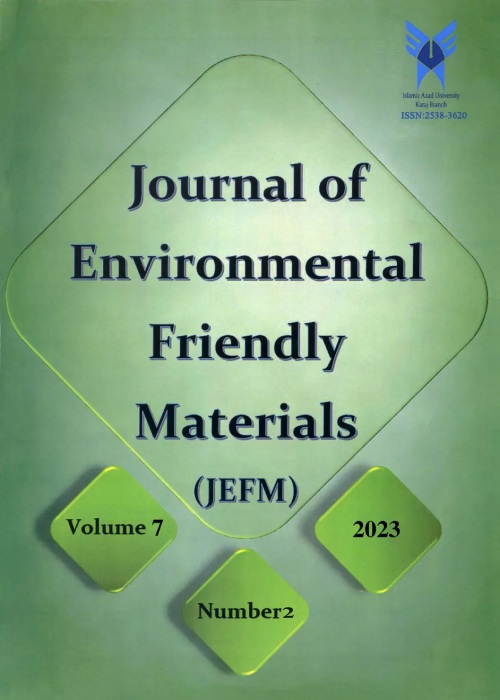فهرست مطالب

Journal of Environmental Friendly Materials
Volume:3 Issue: 2, Summer and Autumn 2019
- تاریخ انتشار: 1398/09/10
- تعداد عناوین: 8
-
Pages 1-3
In this research, Hot tearing Behavior and susceptibility of the Al-Cu A201 aluminum alloy in different mold has been investigated. There are a lot of methods that used for hot tear tests but between all of these methods that proposed for this kind of the tests, The Ring model was employed for testing the hot tearing tendency. In order to increase the investigated parameters, wooden model designated to support different ingate velocities. Some samples that exposed to the Hot Tear were inspected by visual and NDT (None destructive) tests followed by Scanning Electron Microscopy (SEM) to study of the teared surface of the samples. The extracted results show that the number and severity of tears increased by changing the strength of mold from green sand to CO2 sand. The evaluation of the experimental results in this study showed that these results is in good agreement with the other obtained by another researchers
Keywords: Aluminum-Copper Alloys, Hot Tearing, Mold Strength, Critical Velocity -
Pages 5-9
In the present study, the effect of electroplating time on the intensity of flow and the constant potential difference on the thickness of the coating, surface smoothness, microstructure of the interface between substrate and coating and hardness of coating were investigated. Microstructural studies by optical microscopy (OM) showed that increasing the electroplating time leads to increase the coating thickness. Investigations showed that increasing the plating time due to growth leads to increase the surface roughness of coating. In the middle part of the coating, by increasing the time of plating, the thickness of eutectic Ag-Cu film increased. The results of microhardness of coatings showed that the maximum hardness was achieved at the highest planting time i.e 8 minutes. The microhardness remained at a constant range for about half a minute to two minutes, but increasing the time to 4 and 8 minutes leads to increase toughness of 107 and 131 Hv.
Keywords: Silver Coating, Electroplating Time, Coating Thickness, Microhardness -
Pages 11-15
In this study, the environmental effect ( ) of rock wool as a mineral insulation material and expanded polystyrene as a polymer insulation material for a residential building is studied. Initially, the intended building is simulated in Design Builder for warm-dry climate regions like Yazd and Isfahan cities and then the effect of different thicknesses of these two insulation materials inside the external wall of the building is studied towards optimizing the thickness value environmentally. Despite the emissions generated by cooling and heating systems while consuming energy throughout the year, embodied values in the manufacturing process until installation are also considered. Eventually, using the Energy Plus simulation engine inside Design Builder and MATLAB software, the environmental optimum insulation thickness regarding emission and embodied values of for a lifetime of ten years in warm-dry regions of Iran such as Yazd and Isfahan cities are calculated. These values for expanded polystyrene are found to be 20 cm for Isfahan and 19 cm for Yazd and values for rock wool are 11 cm for Isfahan and 10 cm for Yazd. Thus, a mineral insulation material such as rock wool has a smaller environmental optimum insulation thickness than a polymer insulation material such as expanded polystyrene.
Keywords: Thermal Insulation, Optimum Insulation Thickness, Environmental Analysis -
Pages 17-23
In this research, metal cored wire including the ferroalloy materials was used and cladded by FCAW process with different shielding gases as nitrogen and argon on steel substrate. The chemical analysis examination showed that the absorbed nitrogen in all of the samples was fabricated with nitrogen gas shielding. Consequence of XRD pattern indicated that the carbonitride phase (TiCN) precipitations appeared in weld metal that fabricated with shielding of nitrogen gas and titanium carbides (TiC) precipitate in the sample that fabricated with argon shielding gas. Optical and SEM examination results, revealed that the fine particles of titanium carbonitrides and titanium carbides precipitations sited in grain of ferrite structure and the mapping of elements explained the homogeneously precipitates of elements and phases in microstructure. Also, the hardness of sample that fabricated with argon shielding gas was lower than the sample that fabricated with nitrogen shielding gas. The wear test (ASTM G65) result indicated that sample was being consist of TiCN had higher abrasive wear resistance than other sample.
Keywords: Abrasive Wear Resistance, Low Carbon Steel, Titanium Carbonitrides, Titanium Carbides, Composite Cladding -
Pages 25-31
In this study, zinc oxide nanoparticles were obtained from purified solution from the zinc melting residue factory in Bafgh. The obtained nanoparticles by various devices were studied and analyzed. The formation, purity and optical properties of zinc oxide nanoparticles were investigated by the infrared spectrometer (FTIR) test. Ultimately, these nanostructures were used to investigate their photocatalytic properties in the removal of reactive color R198 under UV rays, which has been widely used color in the textile industry and is harmful for the environment. In the bleaching process of reactive color R198, three effective parameters which include the color concentration, pH and amount of nanoparticle were optimized. The results of X-Ray Diffraction patterns (XRD) represent the crystallinity and hexagonal structure of the samples. According to the Transmitted Electron Microscope (TEM) images, the sample have clear spherical shapes and distinct hexagonal dimensions in the range of 40-120nm. Under optimal conditions with color concentration of 30 ml, pH = 7and the amount of nanoparticle 0.12gm at 120 minutes the bleaching process under ultra-violet rays about 99% of the color was degraded or destroyed.
Keywords: Zinc Oxide Nanoparticles, Photocatalytic Properties, Reactive Color, UV Rays -
Pages 33-39
Metallic foams or Metfoams are a new class of advanced materials in environmental friendly materials group. These materials are the family of the cellular materials with low densities and novel physical, mechanical, thermal, electrical and acoustic properties. They are recyclable and nontoxic. They hold particular promise for market penetration in applications in which several of these features are exploited simultaneously. Recent technological advances in the field of metallic foams have led to the development of a wide range of processing techniques for the open, as well as closed cell morphologies. The processing route has to be decided on the basis of the cost of production, material properties, and the intended applications of the final product.
Keywords: Metallic Foams, Environmental Friendly Materials, Advance materials -
Pages 41-47
Environment friendly industrial fin tube boilerused a heat recovery system generator (HRSG) is the core facility of a combined cycle power plant (CCPP) that recycles thermal energy from a gas turbine and creates high temperature and high pressure gas. Serrated finned tubes and solid finned tubes are two types of helically finned tubes made by high-frequency resistance welded (HFRW). Solid and serrated fins are widely consumed solutions for improving heat transfer in fired heaters. The important fact that designers or engineers often overlook while selecting the fins is that serrated fins can provide larger surface area and significantly higher fin efficiency compared with solid fins. Carbon steel and alloy steel tube according to ASTM A192 and ASTM A213. As well as carbon steel and alloy steel coil strips according to ASTM A1008 and ASTM A240-TP409. International standard for tests of high frequency resistance welded fins according ASME and ASTM used for metallography fusion weld, tensile strength and hardness. This paper presents the microstructures welding of helically fin tube boiler, with particular emphasis on HFRW.
Keywords: Helically Finned Tube, High-Frequency, Electric Resistance Welded, Combined Cycle Power Plant -
The Potential of Bamboo as an Environmental Friendly Material in Contemporary Buildings ConstructionPages 49-57
Building materials from their resource extraction through manufacturing, use, and disposal have become the major component of the total human effects on the global ecosystem and earth’s climate, particularly in two centuries since the advent of the industrial revolution. So, the main challenge for the construction industry today is sustainability and there is the urge to adopt cost-effective and eco-friendly structures and materials. The research method of this paper is descriptive-comparative, and is based on a literature survey conducted to find the suitability of such locally available material which is known as “green bamboo”. Bamboo is a strong, fast-growing and very sustainable material, having been used structurally for thousands of years in many parts of the world. In modern times, it has the potential to be an aesthetically pleasing and low-cost alternative to more conventional materials, such as timber, as demonstrated by some visually impressive recent structures. So, in this paper, the potential of bamboo and the possibilities of usage of bamboo in the construction field have been discussed. Applying bamboo as a material which leaves no harm on the surrounding environment can be a counter-movement to create a world with sustainable products in an ecologically supportive way.
Keywords: Bamboo, Environmental Friendly Material, Sustainable Buildings, Contemporary Buildings Construction


